Charles E W Bean, Diaries, AWM38 3DRL 606/273/1 - 1918 - 1937 - Part 19
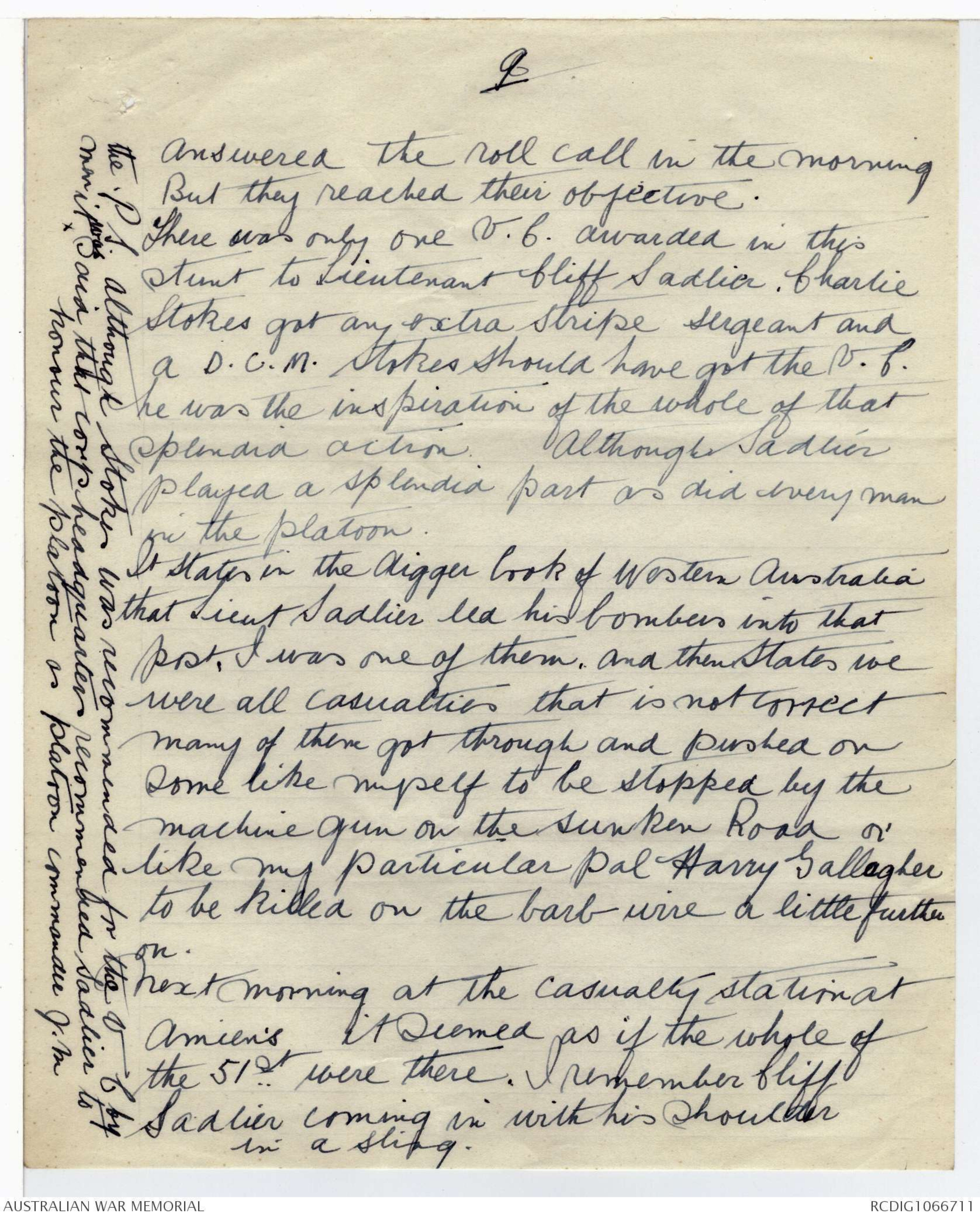

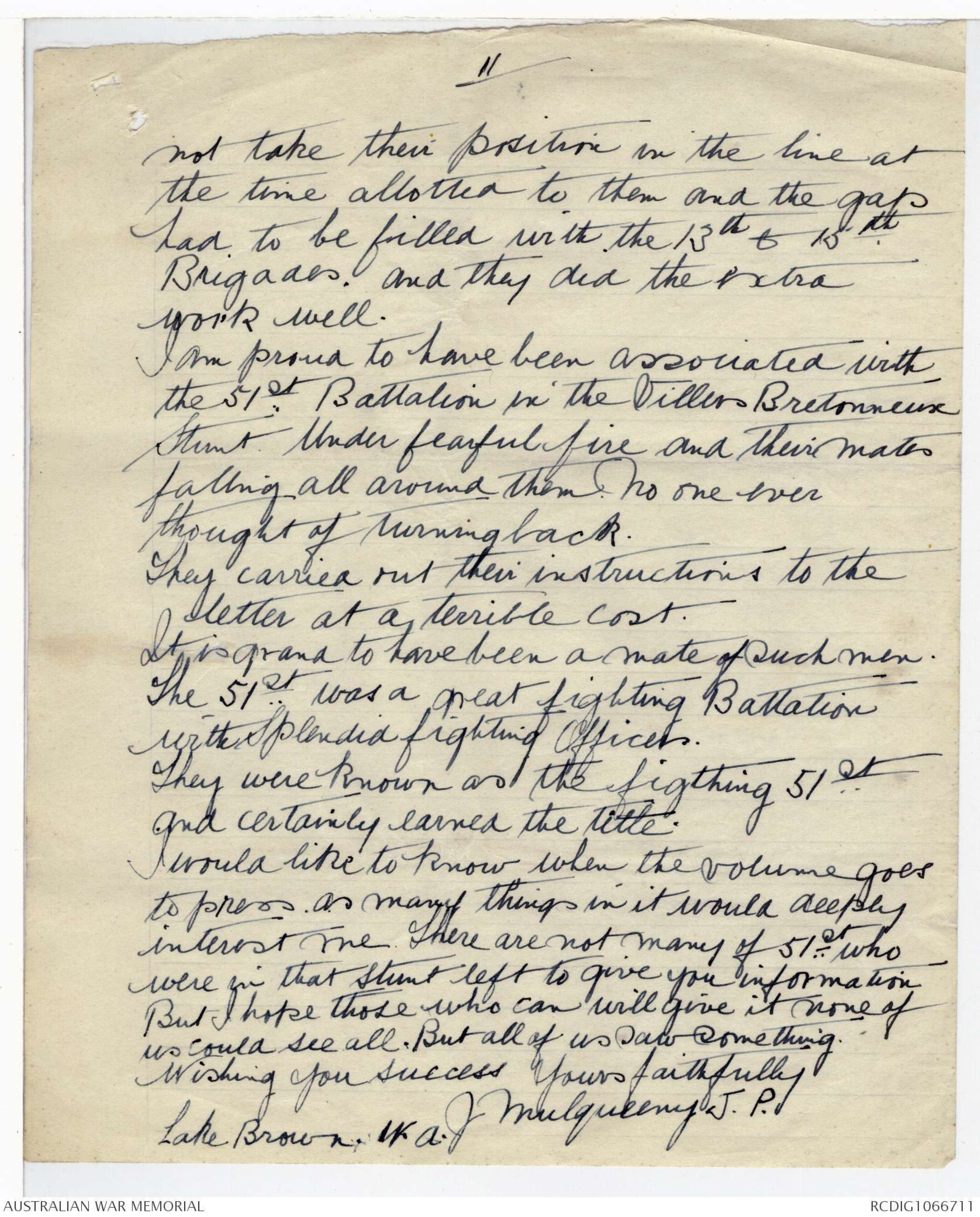
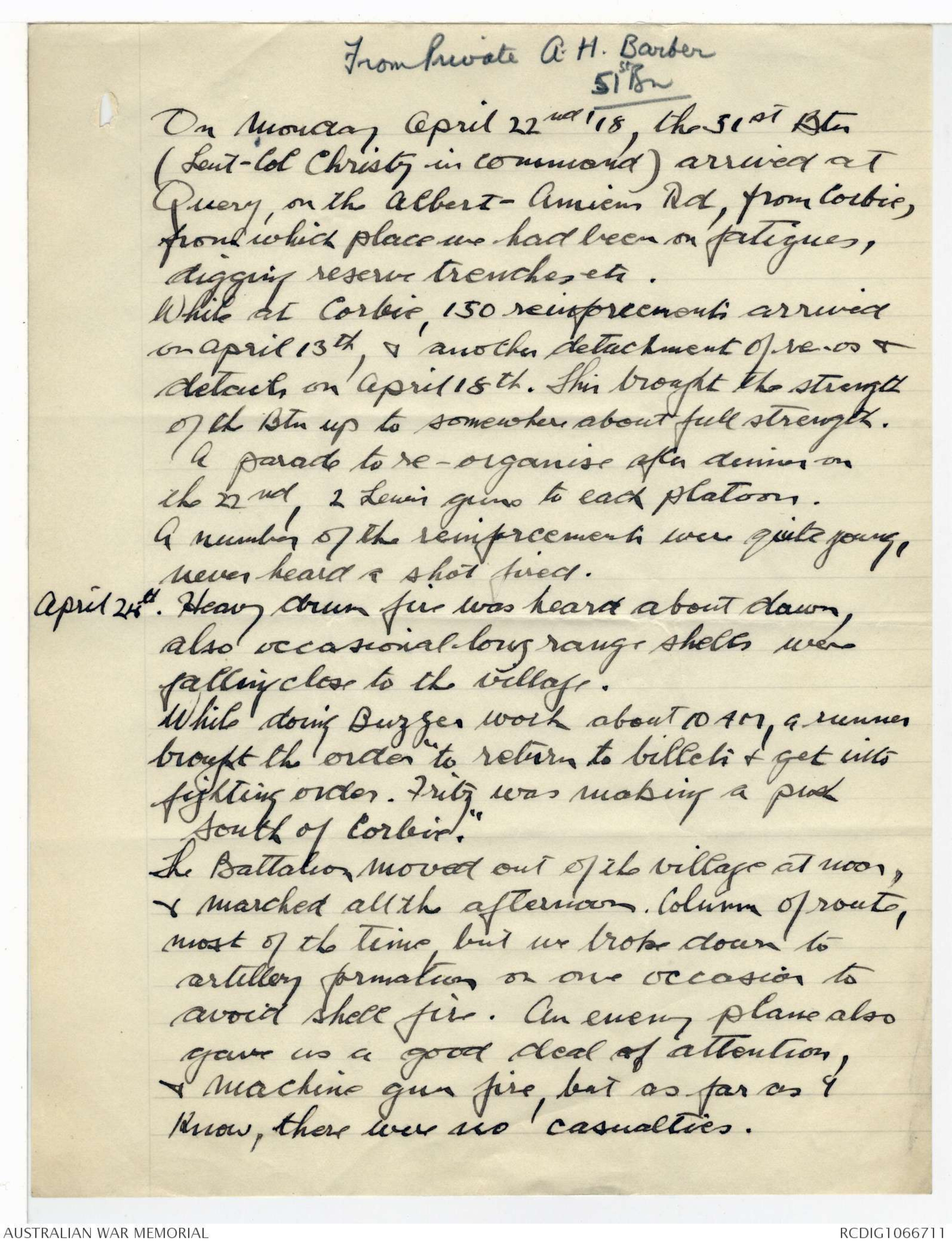
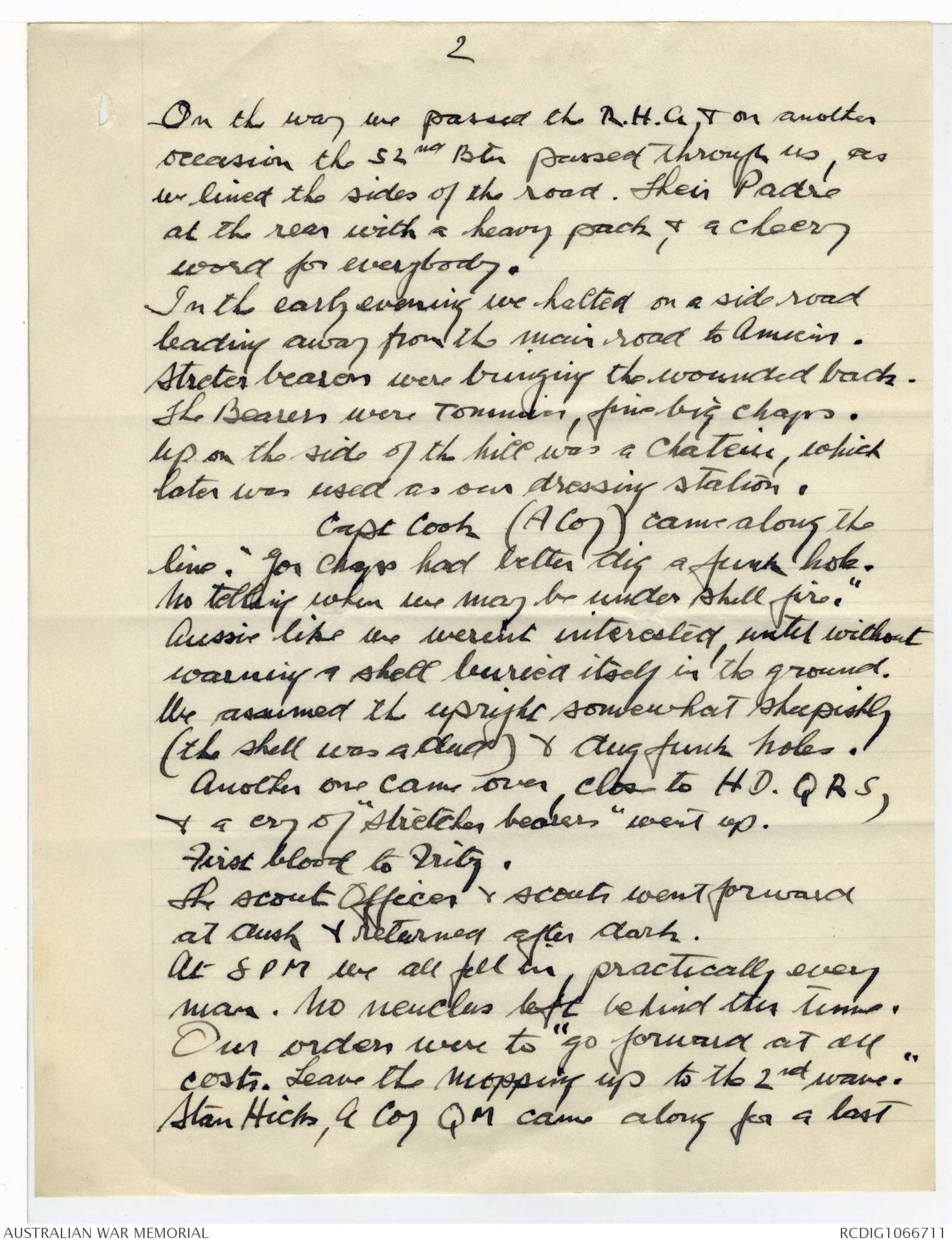
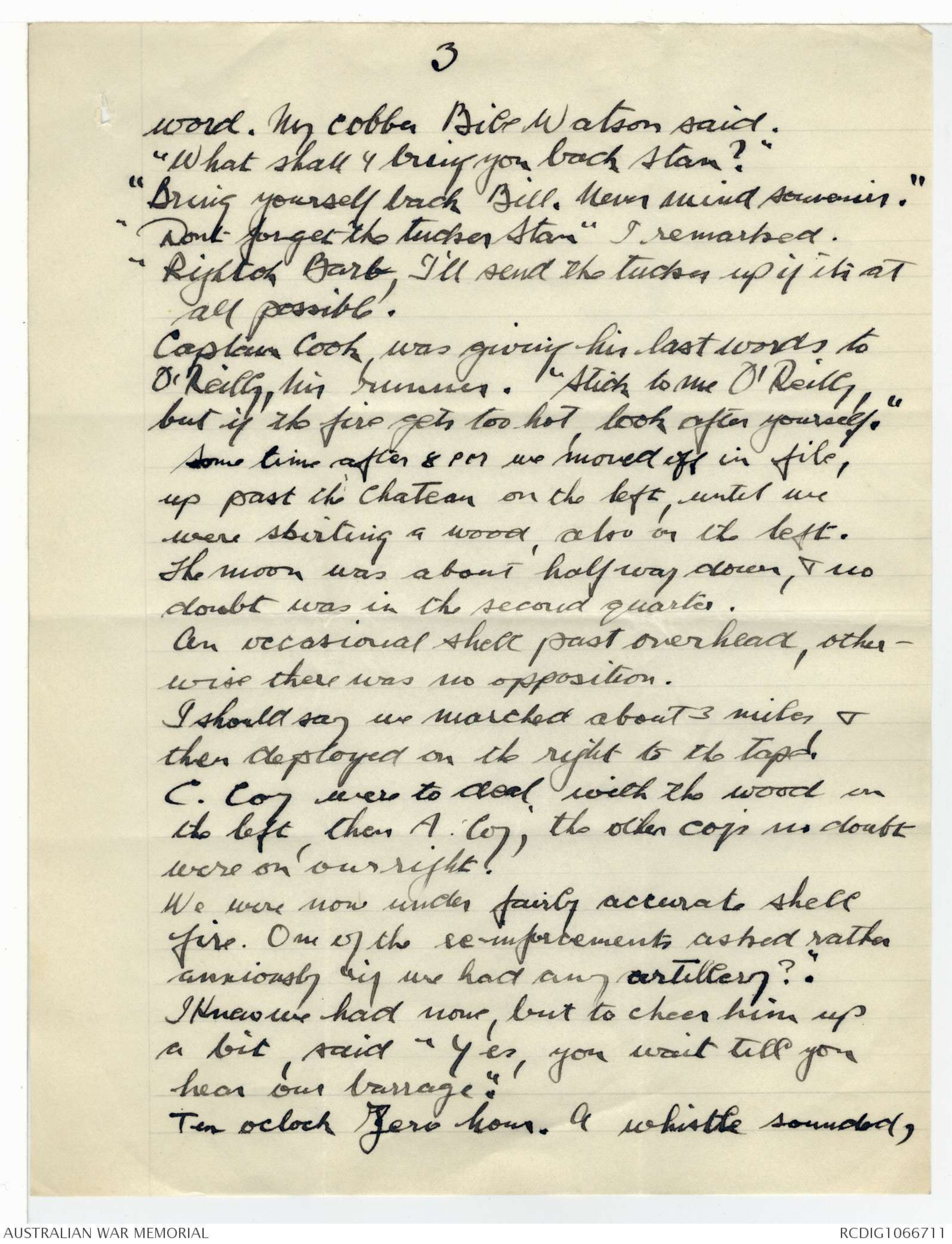
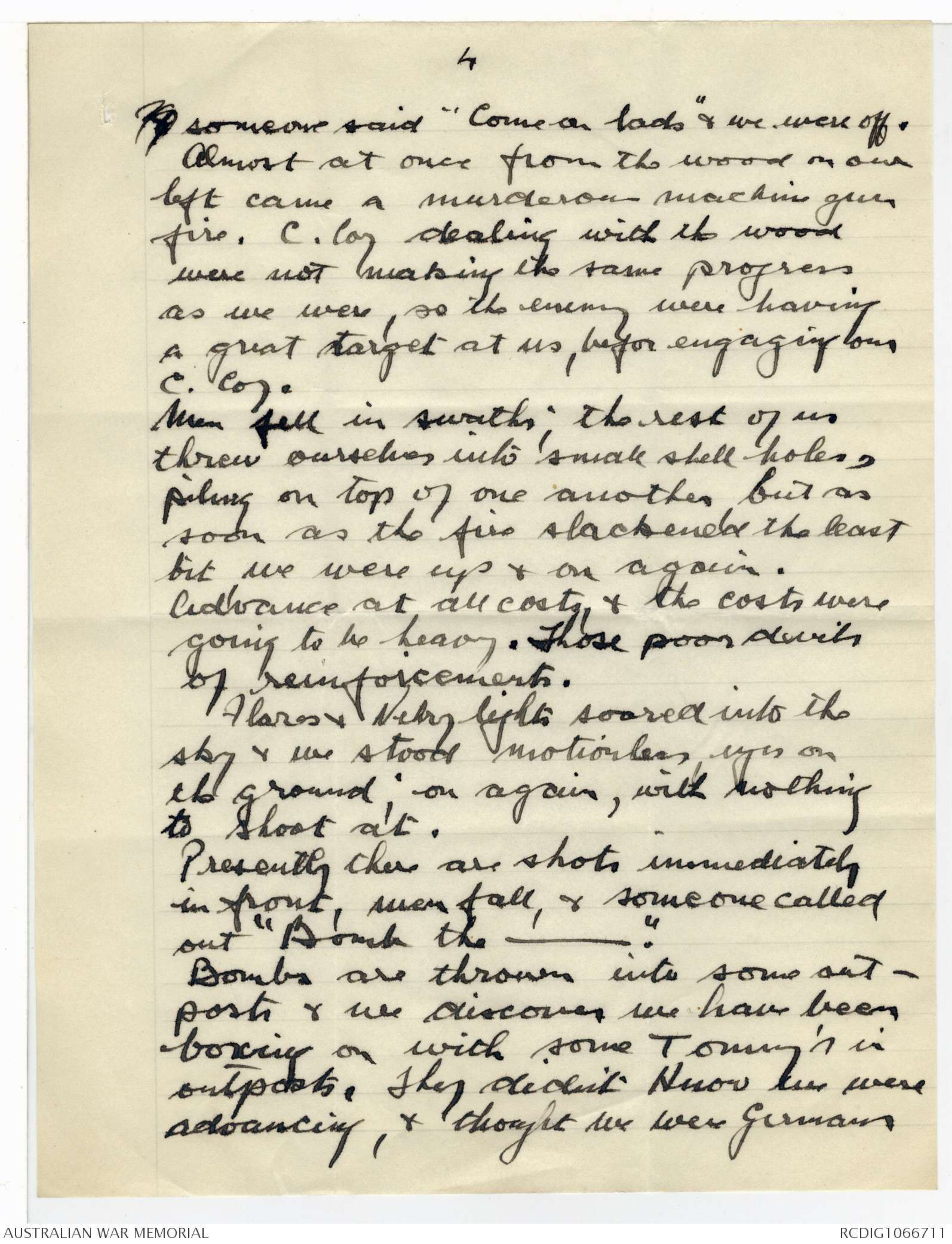
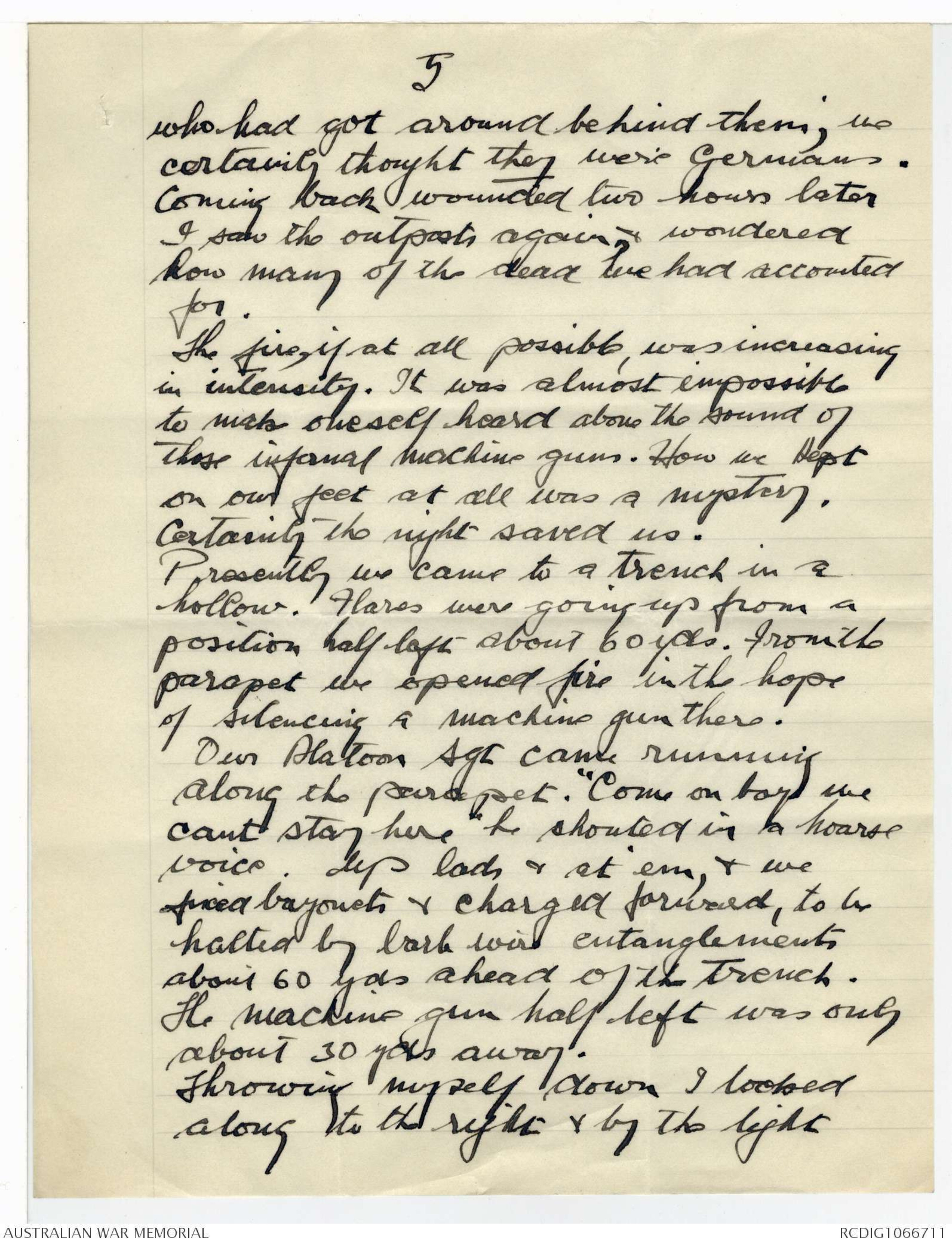

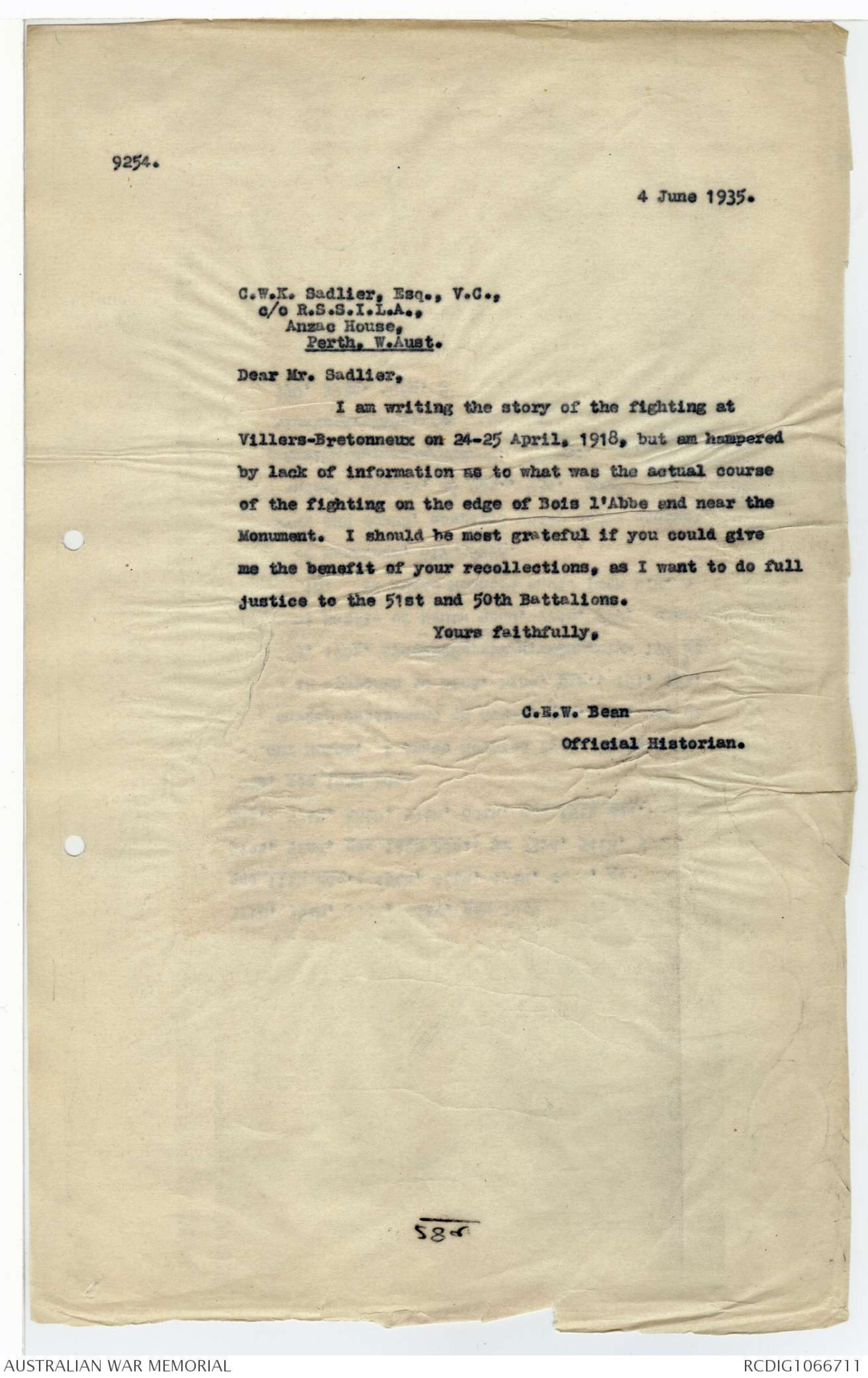
9/
answered the roll call in the morning
But they reached their objective.
There was only one V.C. awarded in this
stunt to Lieutenant Cliff Sadlier. Charlie
Stokes got an extra stripe sergeant and
a D.C.M. Stokes should have got the V.C.
he was the inspiration of the whole of that
splendid action. Although Sadlier
played a splendid part as did every man
in the platoon.
It states in the digger book of Western Australia
that Lieut Sadlier led his bombers into that
post. I was one of them. and then states we
were all casualties that is not correct
many of them got through and pushed on
some like myself to be stopped by the
machine gun on the Sunken Road or
like my particular pal Harry Gallagher
to be killed on the barb wire a little further
on.
Next morning at the casualty station at
Amine's it seemed as if the whole of
the 51st were there. I remember Cliff
Sadlier coming in with his shoulder
in a sling.
[the P.S. although Stokes was recommended for the V.C.by
many ^it was said that corps headquarters recommended Sadlier to
honour the platoon as platoon commander. J.M]
7/ 10/.
We were a badly broken up lot but as
fresh drafts of wounded men from this
great fighting battalion continued to
come along those of us who had
sufficient life raised three cheers for
each lot.
After this I was taken to Rouen hospital for a few
days where a Yankee sister put 13 medicated
[foments?] on my leg in one night and probably
saved it, and then to Bath war hospital for 3
months where the V.A.D. English Sisters were
like angels after the Hell at Villers Bret.
Back again to the Battalion in time to take part
in the latter engagements towards Andenberg line
And luckily got out of them none of them were a
patch on the Villers Bret Stunt.
Other survivors I know who may help you are
Captain Harburn traveller for Mills & Ware Perth
Cliff Sadlier V.C. time keeper Canning Dam W.A.
Charlie Stokes Carrier Subiaco W.A.
M Dick Hardwick education dept Parkerville W.A.
I trust this ^will be of value to you our platoon
played a very important part as we were in the
first wave to go over. And we were badly
let down by the Tommies who did
11/
not take their position in the line at
the time allotted to them and the gap
had to be filled with the 13th & 15th
Brigades. and they did the extra
work well.
I am proud to have been associated with
the 51st Battalion in the Villers Bretonneux
Stunt. Under fearful fire and their mates
falling all around them. No one ever
thought of running back.
They carried out their instructions to the
letter at a terrible cost.
It is grand to have been a mate of such men.
The 51st was a great fighting Battalion
with splendid fighting officers.
They were known as the fighting 51st
and certainly, earned the title.
I would like to know when the volume goes
to press as many things in it would deeply
interest me. There are not many of the 51st who
were in that stunt left to give you information
But I hope those who can will give it none of
us could see all. But all of us saw something.
Wishing you success Yours faithfully
J Mulqueeny J.P.
Lake Brown. W.A.
From Private A.H.Barber
51st Bn
On Monday April 22nd '18, the 51st Btn
(Lieut-Col Christy in command) arrived at
Query, on the Albert-Amiens Rd, from Corbie,
fromwhich place we had been on fatigues,
digging reserve trenches etc.
While at Corbie, 150 reinforcements arrived
on April 13th, & another detachment of re.os &
details on April 18th. This brought the strength
of the Btn up to somewhere about full strength.
A parade to re-organise after dinner on
the 22nd, 2 Lewis guns to each platoon.
A number of the reinforcements were quite young,
never heard a shot fired.
April 28th. Heavy drum fire was heard about dawn,
also occasional long range shells were
falling close to the village.
While doing Buzzer work about 10AM, a runner
brought the order to return to billets to get into
fighting order. Fritz was making a push
south of Corbie."
The Battalion moved out of the village at noon,
& marched all the afternoon. Column of route,
most of the time, but we broke down to
artillery formation on one occasion to
avoid shell fire. An enemy plane also
gave us a good deal of attention,
& machine gun fire, but as far as I
know, there were no casualties.
2
On the way we passed the R.H.Q & on another
occasion the 52nd Btn passed through us, as
we lined the sides of the road. Their Padre
at the rear with a heavy pack, & a cheery
word for everybody.
In the early evening we halted on a side road
leading away from the main road to Amiens.
Stretcher bearers were bringing the wounded back.
The Bearers were Tommies, fine big chaps.
Up on the side of the hill was a chateux, which
later was used as our dressing station.
Capt Cook (A Coy) came along the
line. "You chaps had better dig a funk hole.
No telling when we may be under shell fire."
Aussies like me werent interested, until without
warning a shell buried itself in the ground.
We assumed the upright somewhat sheepishly
(the shell was a dud) & dug funk holes.
Another one came over, closer to HD.Q R S,
& a cry of "stretcher bearers" went up.
First blood to Fritz.
The scout officer & scouts went forward
at dusk & returned after dark.
At 8 PM we all fell in, practically every
man. No [neuclus?] left behind this time.
Our orders were to "go forward at all
costs. Leave the mopping up to the 2nd wave."
Stan Hicks, A Coy QM came along for a last
3
word. My cobber Bill Watson said.
"What shall I bring you back Stan?'
"Bring yourself back Bill. Never mind souvenirs."
"Dont forget the tucker Stan" I remarked.
"Rightoh Barb, I'll send the tucker up if its at
all possible.
Captain Cook was giving his last words to
O'Reilly, his runner. "Stick to me O'Reilly,
but if the fire gets too hot, look after yourself."
Some time after 8 PM we moved off in file,
up past the chateau on the left, until we
were skirting a wood, also on the left.
The moon was about halfway down, & no
doubt was in the second quarter.
An occasional shell past overhead, otherwise
there was no opposition.
I should say we marched about 3 miles &
then deployed on the right to the [?top]
C.Coy were to deal with the wood on
the left, then A.Coy, the other coys no doubt
were on 'our right.'
We were now under fairly accurate shell
fire. One of the reinforcements asked rather
anxiously "if we had any artillery?"
I knew we had none, but to cheer him up
a bit, said "Yes, you wait till you
hear our barrage."
Ten oclock Zero hour. A whistle sounded,
4
XX someone said "Come on lads" & we were off.
Almost at once from the wood on our
left came a murderous machine gun
fire. C.Coy dealing with the wood
were not making the same progress
as we were, so the enemy were having
a great target at us, before engaging on
C.Coy.
Men fell in swaths, the rest of us
threw ourselves into small shell holes,
piling on top of one another but as
soon as the fire slackened the least
bit we were up & on again.
Advance at all costs & the costs were
going to be heavy. Those poor devils
of reinforcements.
Flares & Very lights soared into the
sky & we stood motionless, eyes on
the ground; on again, with nothing
to shoot at.
Presently there are shots immediately
in front, men fall, & someone called
out "Bomb the ________."
Bombs are thrown into some out-
posts & we discover we have been
boxing on with some Tommy's in
outposts. They didn't know we were
advancing, & thought we were Germans
5
who had got around behind them; we
certainly thought they were Germans.
Coming back wounded two hours later
I saw the outposts again, & wondered
how many of the dead we had accounted
for.
The fire, if at all possible, was increasing
in intensity. It was almost impossible
to make oneself heard above the sound of
those informal machine guns. How we kept
on our feet at all was a mystery.
Certainly the night saved us.
Presently we came to a trench in a
hollow. Flares were going up from a
position half left about 60 yds. From the
parapet we opened fire in the hope
of silencing a machine gun there.
Our Platoon Sgt came running
along the parapet. "Come on boys we
cant stay here" he shouted in a hoarse
voice. Up lads & at 'em, & we
fixed bayonets & charged forward, to be
halted by barb wire entanglements
about 60 yds ahead of the trench.
The machine gun half left was only
about 30 yds away.
Throwing myself down I looked
along to the right & by the light
6
of the moon& flares I could see our fellows
pouring throu a gap in the wire.
Jumping up on to one knee I started
pulling up the pickets when I stopped
one in the left shoulder; of the other two
one got it in the neck & one in the gutz.
Making my way back an hour later
I met two tanks going up, at least 2 hours
late.
Capt Cook was killed on the wire entanglements;
Lieut Jack Hitchen & Joe Barrell also.
Sgt'g Geo Smith, Monty Davis, & Geo Nash
done their last hop over.
The casualties for the battalion I believe were
400. (I also heard 700).
From what the boys told me afterwards
they reached their objective alright it
but had lost too many men to do
anything but just hang on.
C.Coy had a stiff job in dealing with machine
gun nests in the wood. The enemy manned
their guns to the last. Some died at their
posts. Lieut Haslem won his VC that
night.
9254.
4th June 1935.
C.W.K. Sadlier, Esq., V.C.,
c/c R.S.S.I.L.A.,
Anzac House,
Perth. W.Aust.
Dear Mr. Sadlier,
I am writing the story of the fighting at
Villers-Bretonneux on 24-25 April, 1918, but am hampered
by lack of information as to what was the actual course
of the fighting on the edge of Bois l'Abbe and near the
Monument. I should be most grateful if you could give
me the benefit of your recollections, as I want to do full
justice to the 51st and 50th Battalions.
Yours faithfully,
C.E.W.Bean
Official Historian.
 Sam scott
Sam scottThis transcription item is now locked to you for editing. To release the lock either Save your changes or Cancel.
This lock will be automatically released after 60 minutes of inactivity.